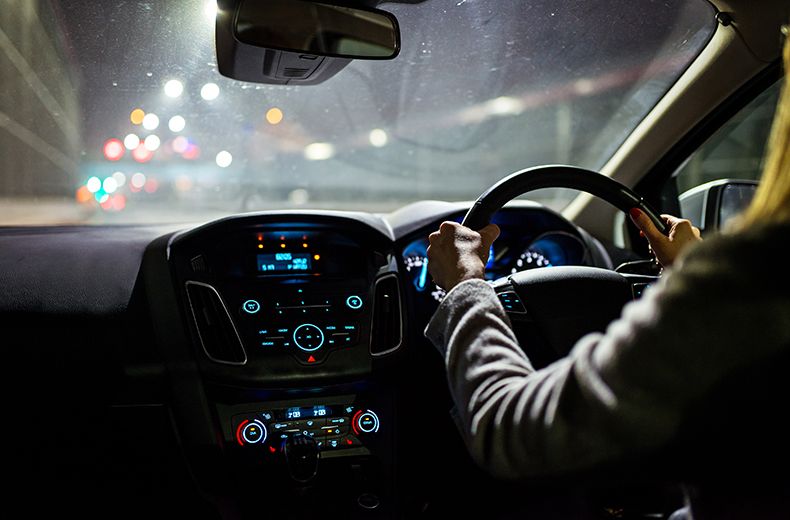The majority of motorists want to be responsible drivers by making sure they avoid alcohol and don’t exceed the speed limit, but tiredness isn’t always given the same consideration.
Read RAC Drive's latest driving advice guide for more tips and advice.
Tips for staying awake behind the wheel
- Rest adequately before setting out on a long journey
- Include 15-minute breaks for every two hours of driving when planning a journey
- If you start to feel sleepy, find a safe place to stop as soon as possible
- Drink two cups of coffee or other high caffeine drinks and have a rest to allow time for the caffeine to kick in
- Avoid making long trips between midnight-6am and 2-4pm when natural alertness is low
- Share the driving if possible
- Avoid eating a big meal before driving – remember this when stopping at a service station for a bite to eat!
Sleep disorders and driving
There are lots of different types of sleep disorders but there is one in particular that is important to think about if you’re a driver. It’s called obstructive sleep apnoea syndrome (OSAS) and symptoms including excessive daytime sleepiness. If treated, sufferers are no more likely to have a road accident than anyone else.
If you have a driving licence and develop a 'notifiable' medical condition (anything that could affect your ability to drive) or disability, or your condition/disability has worsened since getting your licence, you should tell the DVLA.
You can check if a health condition might affect your driving through the DVLA website. You should also ask your doctor if you need to inform the DVLA about your treatment.
It’s important to declare any medical conditions when applying for a car insurance policy and you should check with your provider if your health might impact your policy as well.
Find out more about health conditions and driving.
- 12 ways you could accidentally invalidate your car insurance
- 19 driving myths uncovered
- How where you park overnight impacts your insurance cost

SALE – up to 40% off*
Roadside & Recovery from £5.29 a month*
• Cheaper than AA Price Promise or we’ll beat by 20%^
• We get to most breakdowns in 60 mins or less
• Our patrols fix 4/5 breakdowns on the spot

Symptoms of OSAS include:
- Loud snoring
- Noisy and laboured breathing
- Repeated short periods where breathing is interrupted by gasping or snorting
- Not feeling refreshed after waking up
- Feeling very sleepy during the day
- Poor memory and concentration
- Headaches, particularly in the morning
- Irritability and mood swings
- Depression
- Lack of interest in sex (loss of libido).
If you or a family member thinks there may be more to your tiredness than just the toils of everyday life, see a medical professional to rule out or highlight and treat anything that may be making you less safe behind the wheel.
Is falling asleep behind the wheel illegal?
Any accident that occurs as a result of falling asleep at the wheel is usually classified as 'dangerous driving'.
Dangerous driving is described as driving which “falls far below the standard expected of a competent and careful driver and it would be obvious that driving in that way would be dangerous.”
It can include driving aggressively, overtaking in dangerous locations and racing other vehicles. It also covers "driving when unfit, including having an injury, being unable to see clearly, not taking prescribed drugs, or being sleepy."
Dangerous driving offences will be dealt with by the Magistrates’ Court or Crown Court, depending on the seriousness.
If found guilty, you could be hit with an unlimited fine, a driving ban and up to 14 years in prison.
Find out more about driving offences and their punishments here, or learn how to spot and report dangerous driving.
- Driving in the dark - tips on how to stay safe
- Health conditions and driving: all you need to know
- Safe driving with health issues: from pregnancy to old age
Get 30 driving tips that will save you money
Running a car isn’t cheap, but there are some easy things you can do to keep your costs down. Get these tips and more useful driving articles sent straight to your inbox now.


Technology helping drivers who are feeling tired
There are several technologies in cars designed to help detect and prevent drowsy driving. Many of these are offered as standard in new cars, but in others drivers may need to purchase them.
Driver monitoring systems
These use cameras and sensors to monitor the driver's eye movements and facial expressions. If signs of drowsiness are detected, the system can issue alerts.
Lane departure warning and lane assist
These systems monitor the vehicle’s position within the lane. If the car begins to drift, they provide warnings or can even make minor steering corrections to help keep the driver in the lane. Cars may also emit beeping sounds or play alerts when drowsiness is detected to wake the driver.
Drowsiness detection alert systems
Many cars have built-in systems that track driving patterns and provide warnings if they detect erratic behavior associated with fatigue, like sudden lane changes or braking patterns.
These technologies are becoming increasingly common nd aim to reduce accidents caused by tired drivers.
Driver fatigue
According to road safety charity Brake, driver fatigue is a ‘major cause of road crashes. and could be as dangerous as drink-driving’.
In fact, 10-20% of all crashes are estimated to be caused by fatigue – and one in eight drivers admit to have fallen asleep at the wheel before.
Furthermore, UK police data show that driver fatigue is a factor in about 4% of fatal road crashes and 2% of all collisions.
What is microsleep? And how does it impact drivers?
Brake’s analysis also revealed the impact of ‘microsleep’ for drivers. This is when they close their eyes for two to 30 seconds while driving without realising it.
Analysis showed that 31% of drivers have experienced this while driving. If they have been travelling at 70mph, a six-second microsleep could mean a driver has travelled over 200 metres without noticing.
This is why it is important to take a break from driving if you are feeling tired when driving.

SALE – up to 40% off*
Roadside & Recovery from £5.29 a month*
• Cheaper than AA Price Promise or we’ll beat by 20%^
• We get to most breakdowns in 60 mins or less
• Our patrols fix 4/5 breakdowns on the spot



















